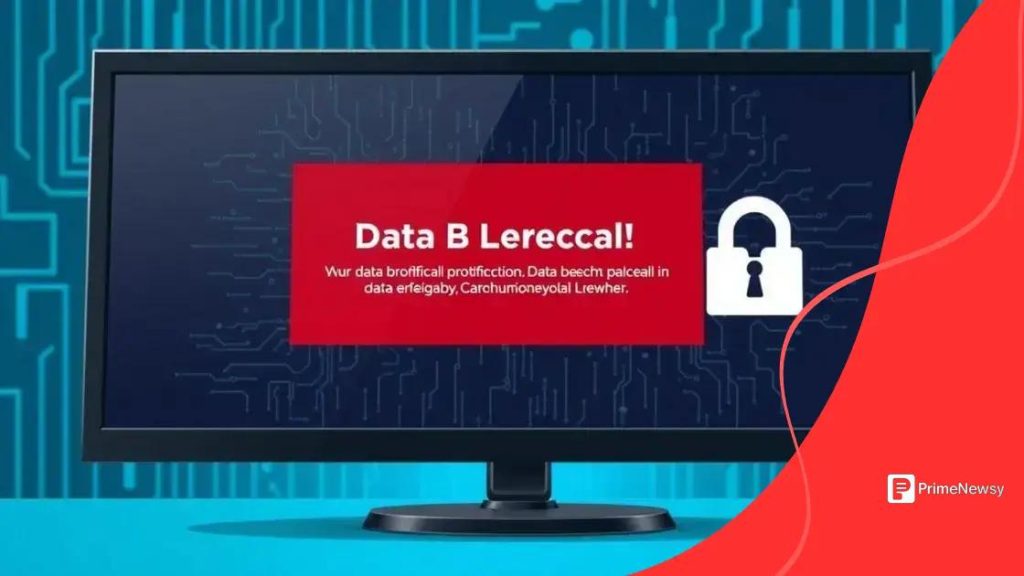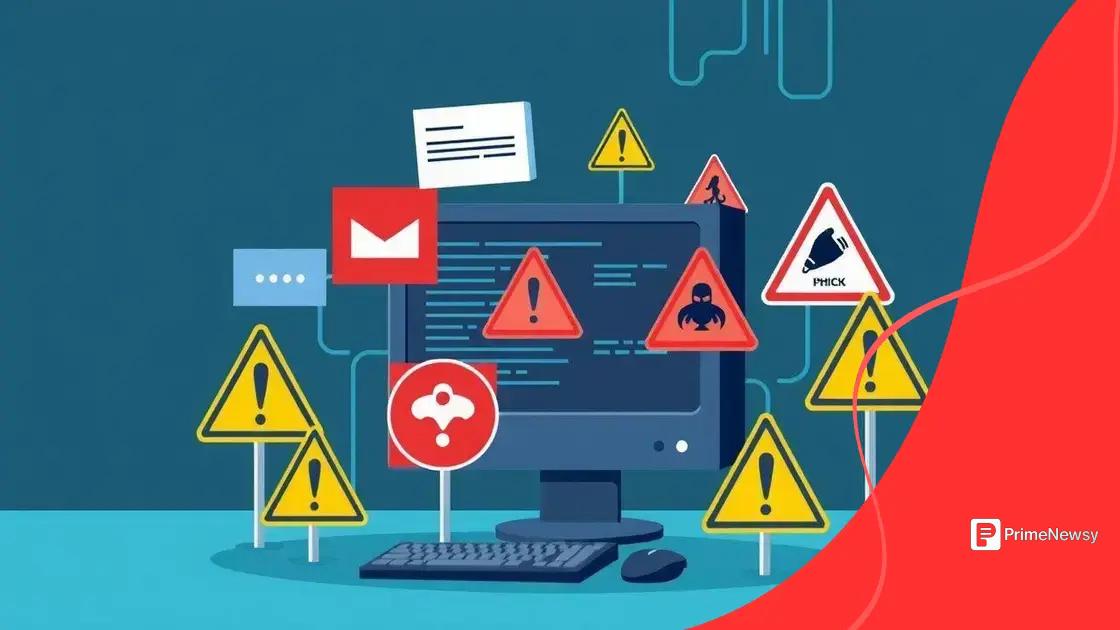Data breach notifications: Are you prepared for the risks?

Anúncios
To protect your personal information, use strong passwords, enable two-factor authentication, be cautious on public Wi-Fi, monitor accounts for unusual activity, and limit the sharing of personal data online.
Data breach notifications have become a vital aspect of cybersecurity in our digital world. With so much personal information online, it’s crucial to understand the implications of such breaches and how they can impact our lives. Have you ever wondered what actions to take when a data breach occurs?
Anúncios
Understanding data breach notifications
Understanding data breach notifications is essential in today’s connected world. When your data is compromised, prompt communication is crucial. Organizations must inform individuals about potential risks to protect their privacy.
What is a data breach notification?
A data breach notification is a formal announcement that a security incident has occurred, potentially compromising personal information. It is vital for transparency and trust. Notifications vary by region but usually include important details about the breach and how affected individuals can respond.
Why are data breach notifications important?
- They inform individuals about risks to their private information.
- They allow for timely protective actions, such as changing passwords.
- They help maintain organizational accountability.
Data breaches can happen due to several reasons. Common causes include inadequate security measures, human error, or cyberattacks. Understanding these causes can help organizations improve their defenses. Additionally, knowing how to react to a breach is equally as important as preventing one. Regular training and cybersecurity protocols should be established.
Anúncios
How do organizations notify individuals?
Most organizations have a protocol for sending out notifications. This usually involves:
- Sending emails to affected individuals.
- Posting announcements on their website.
- Alerting relevant authorities as required by law.
It’s also essential that organizations provide clear instructions on steps individuals should take. This can include monitoring accounts for suspicious activity and updating passwords.
In conclusion, on the topic of data breach notifications, understanding their significance helps both organizations and individuals react appropriately. Effective communication can mitigate potential damages and foster trust between consumers and service providers.
Legal requirements for organizations
Organizations must understand the legal requirements surrounding data breach notifications to comply with local and international laws. Compliance not only protects personal data but also preserves public trust.
Regulatory frameworks
Different regions have specific regulations that dictate how organizations must handle data breaches. For instance, the General Data Protection Regulation (GDPR) in Europe and the California Consumer Privacy Act (CCPA) in the United States set requirements for notifying individuals.
Key aspects of compliance
- Timeliness: Organizations often must notify affected individuals within strict timelines, usually within 72 hours of discovering a breach.
- Content of notifications: Notifications should clearly outline what data was affected and provide steps individuals can take to protect themselves.
- Reporting requirements: Organizations may also need to report breaches to regulatory bodies and law enforcement agencies.
Failure to comply with these regulations can result in hefty fines and reputational damage. Regular training on data breach protocols helps ensure all employees understand their responsibilities.
Best practices for compliance
Here are some best practices organizations can follow to meet legal requirements:
- Maintain an up-to-date inventory of personal data and its storage.
- Conduct regular security audits to identify vulnerabilities.
- Develop a clear response plan for data breaches to ensure quick and compliant action.
Moreover, transparency is crucial. Informing stakeholders about data protection measures and any potential breaches fosters a culture of trust. Companies that prioritize compliance with data breach notifications often experience better customer loyalty and reduced risks.
Common causes of data breaches

Understanding the common causes of data breaches is crucial for businesses looking to protect sensitive information. Many breaches happen due to a mix of technical failures and human mistakes. Recognizing these causes can help organizations implement better security measures.
Human error
One of the leading causes of data breaches is human error. Employees may accidentally send sensitive information to the wrong person or fail to secure data properly. Such mistakes can lead to significant consequences, highlighting the need for training and vigilance.
Weak passwords
Another frequent cause is the use of weak or reused passwords. Many users create simple passwords that are easy to guess. This makes it easier for hackers to gain unauthorized access.
Malware and phishing attacks
- Malware can infiltrate systems through malicious links or attachments.
- Phishing attempts trick users into providing personal information.
- Both tactics are common in today’s cyber threats.
Organizations must prioritize cybersecurity awareness and conduct regular training to reduce risks. Additionally, monitoring networks for unusual activity can prevent many breaches before they escalate.
Insider threats
Insider threats occur when individuals within the organization misrepresent themselves, steal data, or provide it to external parties. This threat can come from current or former employees. Thus, it’s important to vet employees thoroughly and restrict access to sensitive information where possible.
In summary, being aware of the common causes of data breaches allows organizations to take proactive measures. By addressing these vulnerabilities, businesses can enhance their security and protect client data more effectively.
Best practices for responding to breaches
When a data breach occurs, having a solid response plan is vital. Knowing the best practices for responding to breaches can minimize damage and maintain trust with customers. Swift action and clear communication are key components of an effective response.
Establish an incident response team
Once a breach is detected, it’s important to assemble an incident response team. This team should include members from IT, legal, and communications departments. Collaboration allows for a comprehensive response, covering technical fixes and legal obligations.
Communicate promptly
Timely communication with affected individuals is crucial. Inform them about the breach, what information was compromised, and steps they can take to protect themselves. Notifications should be clear and transparent to help build trust.
Assess the breach
- Determine how the breach occurred.
- Identify the data that was compromised.
- Evaluate the potential impact on affected individuals.
In-depth assessment helps organizations understand their vulnerabilities and improve their security posture to prevent future incidents. After analyzing the situation, implementing corrective actions is essential.
Review and improve security measures
Once immediate responses are complete, reviewing current security measures is necessary. This includes examining firewalls, antivirus software, and employee training programs. Regular audits can help identify weaknesses before they are exploited.
Additionally, organizations must keep informed about the latest security threats. This helps to stay ahead of potential future breaches by adopting the right technologies and practices to fend off attackers.
How to protect your personal information
Protecting your personal information is essential in today’s digital age. With increasing numbers of data breaches, knowing how to safeguard your data is crucial. Implementing simple yet effective strategies can minimize risks.
Use strong passwords
Your password is the first line of defense against unauthorized access. Always create strong, unique passwords for each account. Combine uppercase and lowercase letters, numbers, and symbols to enhance security.
Enable two-factor authentication
Two-factor authentication adds an extra layer of protection. This requires you to provide a second piece of information, such as a code sent to your phone, in addition to your password. Enabling this feature can significantly reduce the chances of account compromise.
Be cautious with public Wi-Fi
- Public Wi-Fi networks can expose your data to hackers.
- Avoid accessing sensitive information when connected to these networks.
- If you must use public Wi-Fi, consider using a Virtual Private Network (VPN) for added security.
Monitoring your accounts for any unusual activity is another critical step. Regularly check bank statements and online accounts to identify any unauthorized transactions or changes. Report any suspicious activity immediately.
Limit sharing personal information
Be mindful of the information you share online. Avoid oversharing on social media, as it can lead to identity theft. Review your privacy settings on all accounts to control who can see your personal information.
Additionally, use secure websites when providing sensitive information. Look for “https” in the URL and a lock icon in the address bar. This indicates that the site encrypts your data for secure transmission.
FAQ – Frequently Asked Questions about Protecting Personal Information
Why is it important to use strong passwords?
Strong passwords are the first line of defense against unauthorized access to your accounts, making it much harder for hackers to gain entry.
What are the benefits of enabling two-factor authentication?
Two-factor authentication adds an extra layer of security by requiring not just a password but also a second form of verification, greatly reducing the risk of unauthorized access.
How can public Wi-Fi impact my personal information?
Public Wi-Fi networks are often insecure, making it easier for hackers to intercept your data. Avoid accessing sensitive information on these networks.
What should I do if I notice unusual activity on my accounts?
Immediately report any suspicious activity to your bank or service provider, change your passwords, and monitor your accounts for additional unauthorized transactions.